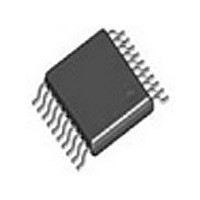LM4884MHX/NOPB National Semiconductor, LM4884MHX/NOPB Datasheet - Page 15

LM4884MHX/NOPB
Manufacturer Part Number
LM4884MHX/NOPB
Description
IC AMP AUDIO 2.6W STER 20TSSOP
Manufacturer
National Semiconductor
Series
Boomer®r
Type
Class ABr
Datasheet
1.LM4884MHXNOPB.pdf
(22 pages)
Specifications of LM4884MHX/NOPB
Output Type
2-Channel (Stereo)
Max Output Power X Channels @ Load
2.6W x 2 @ 3 Ohm
Voltage - Supply
3 V ~ 5.5 V
Features
Depop, Differential Inputs, Shutdown, Thermal Protection
Mounting Type
Surface Mount
Package / Case
20-TSSOP Exposed Pad, 20-eTSSOP, 20-HTSSOP
Operational Class
Class-AB
Audio Amplifier Output Configuration
2-Channel Stereo
Output Power (typ)
2.6x2@3OhmW
Audio Amplifier Function
Speaker
Total Harmonic Distortion
0.3@4Ohm@2W%
Single Supply Voltage (typ)
5V
Dual Supply Voltage (typ)
Not RequiredV
Power Supply Requirement
Single
Rail/rail I/o Type
No
Power Supply Rejection Ratio
62dB
Single Supply Voltage (min)
3V
Single Supply Voltage (max)
5.5V
Dual Supply Voltage (min)
Not RequiredV
Dual Supply Voltage (max)
Not RequiredV
Operating Temp Range
-40C to 85C
Operating Temperature Classification
Industrial
Mounting
Surface Mount
Pin Count
20
Package Type
TSSOP
Lead Free Status / RoHS Status
Lead free / RoHS Compliant
Other names
LM4884MHX
Typical Performance Characteristics
Application Information
OPTIMIZING RF IMMUNITY
The internal circuitry of the LM4884 suppresses the amount
of RF signal that is coupled into the chip. However, certain
external factors, such as output trace length, output trace
orientation, distance between the chip and the antenna,
antenna strength, speaker type, and type of RF signal, may
affect the RF immunity of the LM4884. In general, the RF
immunity of the LM4884 is application specific. Neverthe-
less, optimal RF immunity can be achieved by using short
output traces and increasing the distance between the
LM4884 and the antenna.
PCB LAYOUT AND SUPPLY REGULATION
CONSIDERATIONS FOR DRIVING 3W AND 4W LOADS
Power dissipated by a load is a function of the voltage swing
across the load and the load’s impedance. As load imped-
ance decreases, load dissipation becomes increasingly de-
pendent on the interconnect (PCB trace and wire) resistance
between the amplifier output pins and the load’s connec-
tions. Residual trace resistance causes a voltage drop,
which results in power dissipated in the trace and not in the
load as desired. For example, 0.1Ω trace resistance reduces
the output power dissipated by a 4Ω load from 2.1W to 2.0W.
This problem of decreased load dissipation is exacerbated
as load impedance decreases. Therefore, to maintain the
highest load dissipation and widest output voltage swing,
PCB traces that connect the output pins to a load must be as
wide as possible.
Poor power supply regulation also adversely affects maxi-
mum output power. A poorly regulated supply’s output volt-
age decreases with increasing load current. Reduced supply
voltage causes decreased headroom, output signal clipping,
and reduced output power. Even with tightly regulated sup-
plies, trace resistance creates the same effects as poor
supply regulation. Therefore, making the power supply
traces as wide as possible helps maintain full output voltage
swing.
A = Left channel driven, right channel measured;
B = Right channel driven, left channel measured
V
DD
Cross Talk vs Frequency
= 3V, R
L
= 8Ω, A
15
(Continued)
BRIDGE CONFIGURATION EXPLANATION
As shown in Figure 1, each of the LM4884’s stereo channels
consists of two operational amplifiers. The LM4884 can be
used to drive a speaker connected between the two outputs
of each channel’s amplifiers.
Figure 1 shows that the output of Amp1 serves as the input
to Amp2, which results in both amplifiers producing signals
identical in magnitude, but 180˚ out of phase. Taking advan-
tage of this phase difference, a load is placed between
OUT+ and OUT- and driven differentially (commonly referred
to as "bridge mode"). This results in a differential gain of
Bridge mode is different from single-ended amplifiers that
drive loads connected between a single amplifier’s output
and ground. For a given supply voltage, bridge mode has a
distinct advantage over the single-ended configuration: its
differential output doubles the voltage swing across the load.
This results in four times the output power when compared
to a single-ended amplifier under the same conditions. This
increase in attainable output assumes that the amplifier is
not current limited or the output signal is not clipped. To
ensure minimum output signal clipping when selecting one
of the amplifier’s four closed-loop gains, refer to the Audio
Power Amplifier Design section.
Another advantage of the differential bridge output is no net
DC voltage across the load. This results from biasing OUT+
and OUT- at half-supply. This eliminates the coupling capaci-
tor that single supply, single-ended amplifiers require. Elimi-
nating an output coupling capacitor in a single-ended con-
figuration forces a single supply amplifier’s half-supply bias
voltage across the load. The current flow created by the
half-supply bias voltage increases internal IC power dissipa-
tion and may permanently damage loads such as speakers.
V
= 21.6dB,
201163D6
A
VD
= 2(R
F
/R
I
)
www.national.com
(1)











